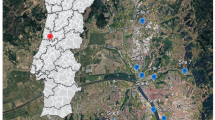Abstract
The draining of the Lake Hula and swamps, northern Israel, during the late 1950s resulted in the loss of a very diverse and rare ecosystem. Oxidation of the peat soil resulted in ground surface subsidence, while heavy autumn winds have eroded the dry peat. Moreover, agriculture on the peat soils is restricted, because of a nitrate surplus. Predictions that the sinking would continue and that more areas would go out of agricultural production led authorities to re-flood a portion of the Hula Valley in 1994. The aim of the present study was to monitor the spontaneous establishment of vegetation in the re-flooded area, the Agmon wetlands, and to reestablish some of the major plant species lost from the valley when Lake Hula was drained. Within the first two years, 74 plant species colonized the wetland spontaneously. Five out of 11 species designated for reintroduction were successfully established. Cyperus papyrus and Cynodon dactylon demonstrated sustainable potential for lake-shore stabilization. Cyperus papyrus was reintroduced from seedlings and rapidly became the dominant riparian species, while Cynodon dactylon established spontaneously. Re-introduced Nymphaea alba clones were established only in enclosures protected from grazing by the semi-aquatic mammal Myocastor coypu. Nuphar lutea and Iris pseudacorus showed better resistance to grazing. These results demonstrate a high potential for successful re-establishment of much of the original Hula swamp macrophytic vegetation by either spontaneous colonization by extant species from the surrounding areas or by introduction of locally extinct species. As such, there is a good chance that the associated faunal components of the former Lake Hula and swamps that have returned to the region since the Hula rehabilitation project commenced will continue to flourish.
Similar content being viewed by others
References
Ashkenazi, S. and Dimentman, Ch. 1998. Foraging, nesting and roosting habitats of the avian fauna of the Agmon wetland, northern Israel. Wetlands Ecol. Managmt. 6: 169-187.
Bales, M., Moss, B., Philips, G., Irvine, K. and Stansfield, J. 1993. The changing ecosystem of a shallow, brackish lake, Hickling Broad, Norfolk, UK. II. Long-term trends in water chemistry and ecology and their implications for restoration of the lake. Freshwater Biol. 29: 145-165.
Bowles, M.L. and Whelan, C.J. 1994. Restoration of Endangered Species. Cambridge Univ. Press.
Dafni, A. and Agami, M. 1976. Extinct plants of Israel. Biol. Conserv. 10: 49-51.
Davis, S.M. 1994. Phosphorus inputs and vegetation sensitivity in the Everglades. In:Davis, S.M. and Ogden, J.C. (eds), Everglades: The Ecosystem and its Restoration. pp. 357-378. St. Lucia Press, Delray Beach.
Dimentman, Ch., Bromley, H.J. and Por, F.D. 1992. Lake Hula: Reconstruction of the Fauna and Hydrobiology of a Lost Lake. The Israel Academy of Science and Humanities, Jerusalem.
Feinbrun-Dotan, N. 1977. Flora Palaestina, Vols. 3 and 4. The Israel Academy of Science and Humanities, Jerusalem.
Hambright, K.D. and Zohary, T. 1998. Lakes Hula and Agmon: destruction and creation of wetland ecosystems in northern Israel. Wetlands Ecol. Managmt. 6: 83-89.
Jones, R.F. 1940. Report of the Percy Sladen Expedition to Lake Hula: a contribution to the study of fresh waters of Palestine. J. Ecol. 28: 357-376.
Kaplan, D. and Vaadia, J. 1992. The Hula Swamp. Preview of habitats for rehabilitation. Report to the Israel Nature Reserves Authority, Jerusalem (in Hebrew).
Livne, M. 1994. The new Hula project. Ecol. Environ. 1: 211-220 (in Hebrew).
Maltby, E. and Dugan, P.J. 1994. Wetland ecosystem protection, management and restoration: an international perspective. In:Davis, S.M. and Ogden, J.C. (eds), Everglades: the Ecosystem and its Restoration. pp. 29-46. St. Lucies Press, Florida.
Markel, D., Sass, E., Lazar, B. and Bein, A. 1998. Biogeochemical evolution of a sulfur-iron rich aquatic system in a reflooded wetland environment (Lake Agmon, northern Israel). Wetlands Ecol. Managmt. 6: 103-120.
Paz. U. 1975. Rehabilitation of the Hula Nature Reserve. Nat. Cons. Isr. 1: 116-206 (in Hebrew).
Peltre, M.C., Leglize, L. and Salleron, J.L. 1993. Aquatic vegetation and phosphorus contents in a small river: consequences of a reduction in phosphorus levels. Bull. Fr. Peche Piscicult. 331: 357-371.
Shacham, G. 1994. The new Hula project. Ecol. Environ. 1: 221- 224 (in Hebrew).
Shy, E., Beckerman, S., Oron, T. and Frankenberg, E. 1998. Repopulation and colonization by birds in the Agmon wetland, Israel. Wetlands Ecol. Managmt. 6: 159-167.
Van Donk, E. 1990. Necessity for aquatic plant management after lake restoration by manipulation. In:Barret, P.R.F., Greaves, M.P., Murphy, K.J., Pieters, A.H. and P.M. Wade (eds), Proc. 8th Int. Symp. on Aquatic Weeds. pp. 91-96. Uppsala, Sweden.
Van Wijck, C., Grillas, P., De Groot, C.J. and Ham, L.T. 1994. A comparison between the biomass production of Potamogeton pectinatusand Myriophyllum spicatumin the Camargue (southern France) in relation to salinity and sediment characteristics. Vegetatio 113: 171-180.
Zohary, M. and Orshansky, G. 1947. The vegetation of the Huleh plain. Palestine J. Bot. 4: 90-104.
Zohary, M. 1966. Flora Palaestina, Vols. 1 and 2. The Israel Academy of Sciences and Humanities, Jerusalem.
Zohary, M. 1982. Vegetation of Israel and adjacent areas. In:Blume, H. and W. Frey (eds), Beihefte zum Tubinger Atlas des vondern Orients. pp. 146-160. Dr. Ludwing Reichert Verlag, Wiesbaden.
Author information
Authors and Affiliations
Rights and permissions
About this article
Cite this article
Kaplan, D., Oron, T. & Gutman, M. Development of macrophytic vegetation in the Agmon Wetland of Israel by spontaneous colonization and reintroduction. Wetlands Ecology and Management 6, 143–150 (1998). https://doi.org/10.1023/A:1008420120533
Issue Date:
DOI: https://doi.org/10.1023/A:1008420120533




